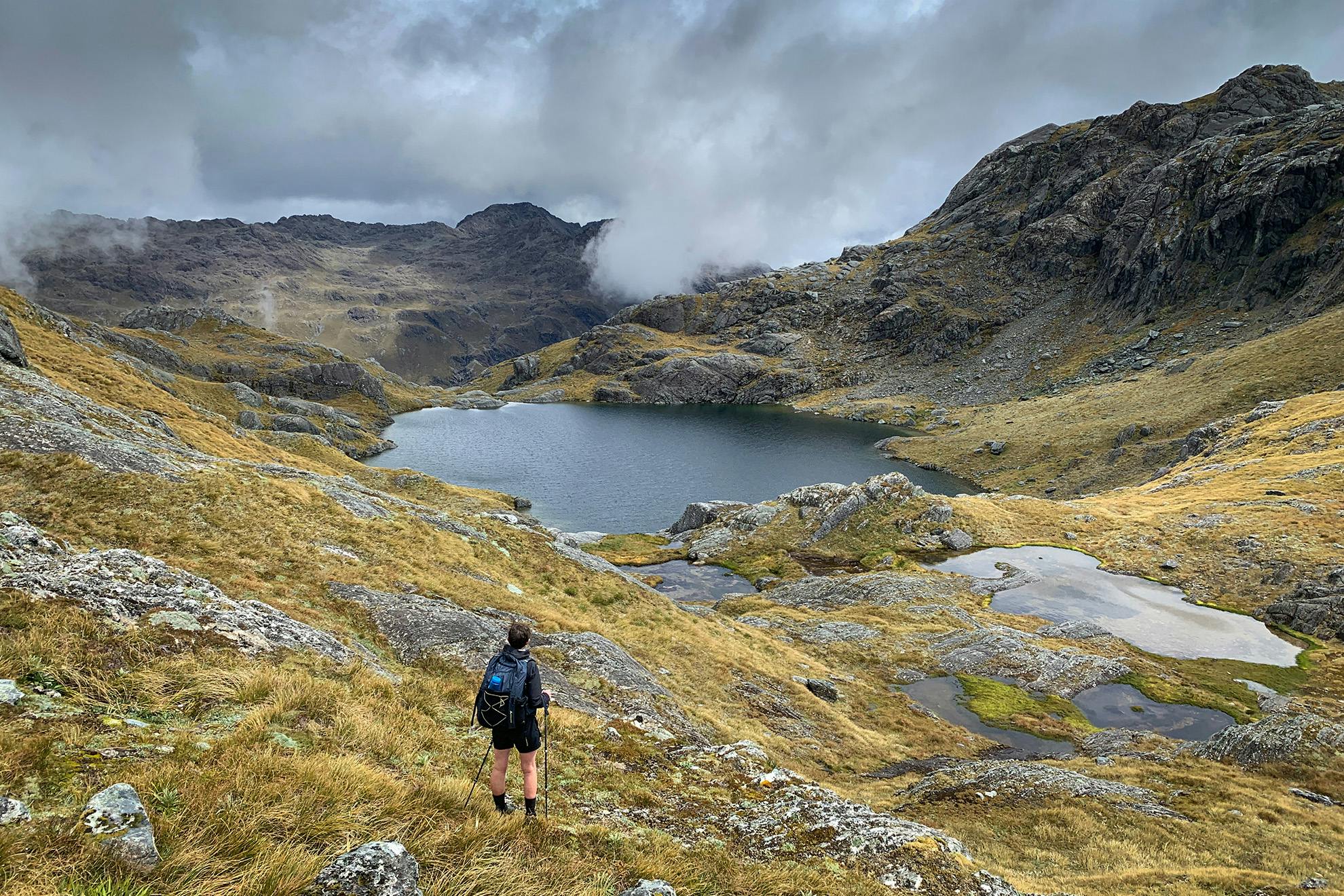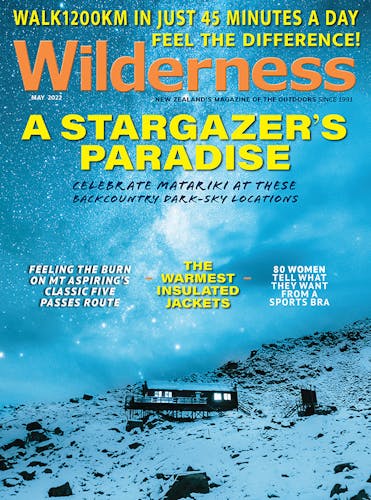The classic Five Passes Route traverses the Rock Burn and Beans Burn valleys – a landscape as stunning and beautiful as the nearby Route Burn. By Sarah White
Three shadows crouched on a ledge above the entrance to the cave, poking sticks into a smouldering fire. Dressed in black and with bare feet, they looked like figures from a dystopian movie.
“Any room at the inn?” we chirped hopefully.
“There might be if you squeeze through the pinch; there are others in there somewhere,” replied one of the dark shapes.
Reports had implied Split Rock Biv was a mansion with three rooms, snow grass-carpeted floors and lovingly crafted stone walls. Blundering down from Fohn Saddle in freezing rain, we’d dreamed of the biv’s dry comfort. We hadn’t stopped for lunch; we were wet, cold, and grumpy; and the only accommodation was a one-metre–high pitch-black crevice.
The cave dwellers recognised our state and rallied. Mat and Amy helped with the tent and boiled some water on their fire. Things looked rosier with a mug of tomato soup in hand and the sun peeping through the rain.
This classic route leads trampers over five passes between the Rock Burn and Beans Burn valleys in Mt Aspiring National Park. It has become popular despite there being no huts and much of the circuit is untracked and unmarked. In mid-summer and travelling in a clockwise direction, opposite to what most take, we met numerous parties doing the trip.
The first few hundred metres is on the manicured Routeburn Track before a sign directs trampers uphill towards Sugarloaf Pass. This is 600m of vertical grind and the track, in contrast to Great Walk-land, is rough and rooty.
When the scrubby bush margins were cleared, the view back to Glenorchy and Lake Wakatipu is stunning, and then, from the pass, are wide views of the Rock Burn, Mt Earnslaw and the Dart Valley.
We welcomed the descent into the cool of the bush before the track opened out again and the Rock Burn Valley lay before us. We wandered for a couple of hours through lush and sometimes boggy grasslands, alternating with forest, before reaching Theatre Flat, which is perfect for camping.
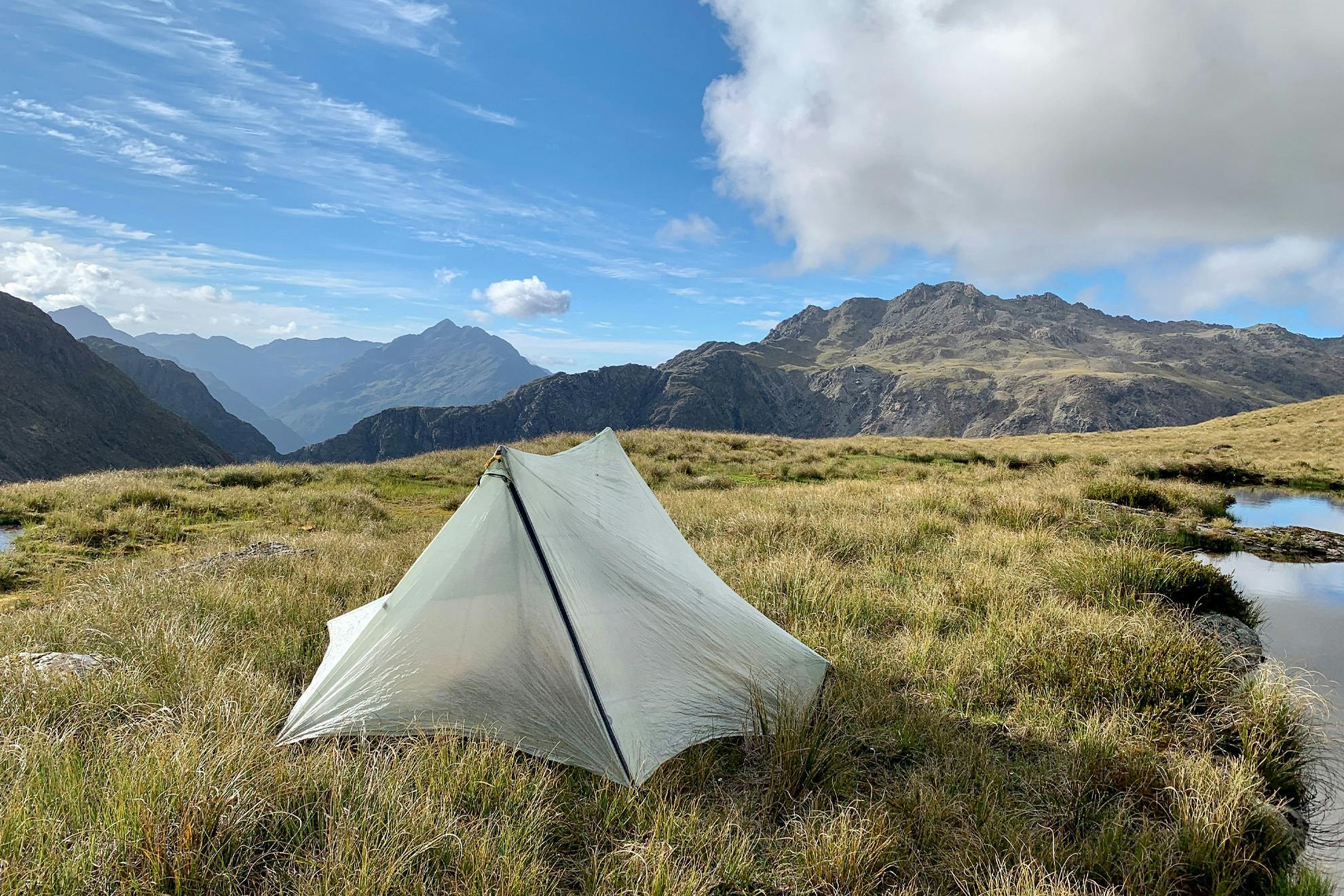
But, keen to get as much distance in before the forecast rain the next day, our destination for the night lay onwards – and upwards – to Park Pass, the second of the Five Passes. However, by 7.30pm we still hadn’t reached it and, tired, I called a halt. We camped on a rare smidgeon of flat ground amidst lumpy tussock, but at least it was above the sandflies. The infant Rock Burn burbled and kea called. A couple who overnighted in the rock bivvy not far from us said they were kept awake until the early hours by kea playing with sticks.
Our goal the next day was unrealistic. With the rain due, we wanted to get over the remaining passes and into the Beans Burn before it arrived. First was Park Pass which was clagged in swirling mist, so there were no views. With the help of a GPS, we crossed the pass and plodded down the sparsely-cairned track towards Hidden Falls Creek. We felt relief at descending this section rather than climbing the closely-spaced contours.
At the creek, the sun breached the clouds and the mid-morning wander along the bushy flats flanking it was a highlight. Moirs Guide advised crossing the creek on the true left where the shingle slips start. From there, it’s straightforward to pick a route through boulder land, following the creek ever upwards.
The third pass is the moonscape of Cow Saddle (1025m), which is one of those good saddles where once at the top, you don’t have to go down again before heading for the next pass. It’s straight up to Fiery Col (1546m) with no altitude loss.
After lunch, it’s a right turn and further climbing towards the fiery red rocks of the fourth pass. This is ultramafic rock, high in iron and potassium. The red colouration is caused by the iron content rusting.
A rushing stream bisects the approach to the Col but it’s easy to cross further up before a sidle along ledges to a final steep pitch. All up, another 500 vertical metres; our height gain for the day, and corresponding tiredness, was mounting.
A patch of snow below the col was elegantly boot skied by an approaching tramper. This was the only snow and we were glad we hadn’t carried the extra weight of ice axes.
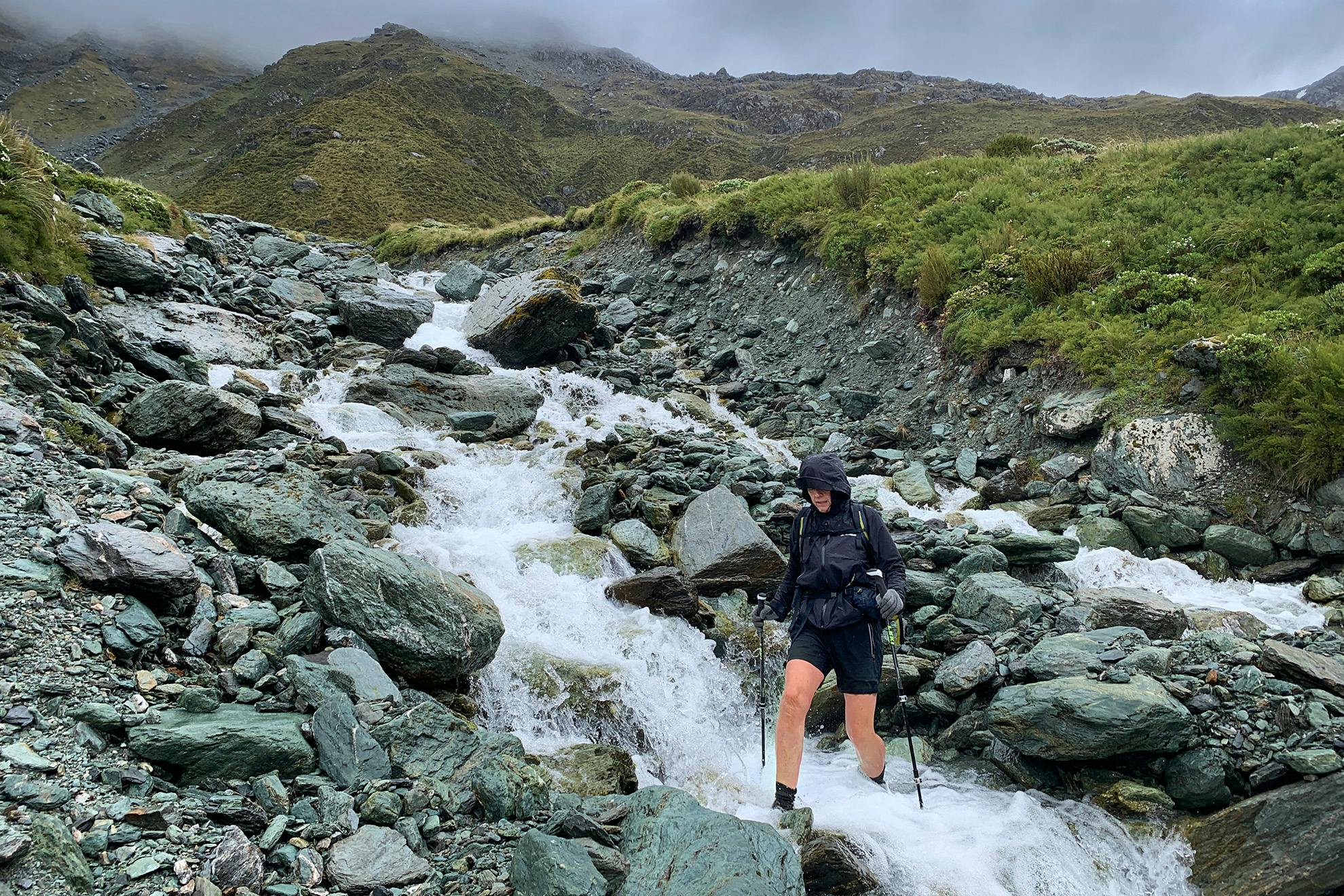
From Fiery Col there is a tremendous panorama across to the Olivine Ledge and Forgotten River to the approach to the tramping mecca of the Olivine Plateau. We’d briefly considered climbing onto the Plateau but, surveying the distances from Fiery Col, decided not to. There was a cold breeze and clouds were rolling in, so we headed on down.
We decided against camping on the Olivine Ledge, which sounded almost as romantic as camping on the Olivine Plateau, because Paul wanted to push on over Fohn Saddle to the promised luxury of Split Rock Biv.
We gingerly picked our way off the col and into Fiery Creek, traversing onto the Ledge at 1200m. Snow marguerites, Mt Cook buttercups and mountain daisies were all blooming among the tussock on the sodden terrain.
It was late in the afternoon and though Paul still wanted to climb the very steep 300m hillside, I persuaded him to pitch the tent in a less-wet area beside a small tarn. The tough dyneema fabric floor of our tent proved its worth on this marsh.
That night, we dined on a tasty chickpea curry of my creation and our quality of life improved with the discovery of a flat warm rock to share whilst eating and enjoying our surroundings. I was pleased not to be dragging myself up a steep hill; now being just metres from my bed, camped up high and surrounded by majestic mountain country.
The promised rain arrived early the next morning and after a cuppa we snuggled back into our bags, waiting for it to lighten. It felt like total wilderness camping but when we finally poked our heads out to start packing, a party of five headed for Fiery Col waltzed by. Then, a short distance away, we found another tent, occupants yet to emerge.
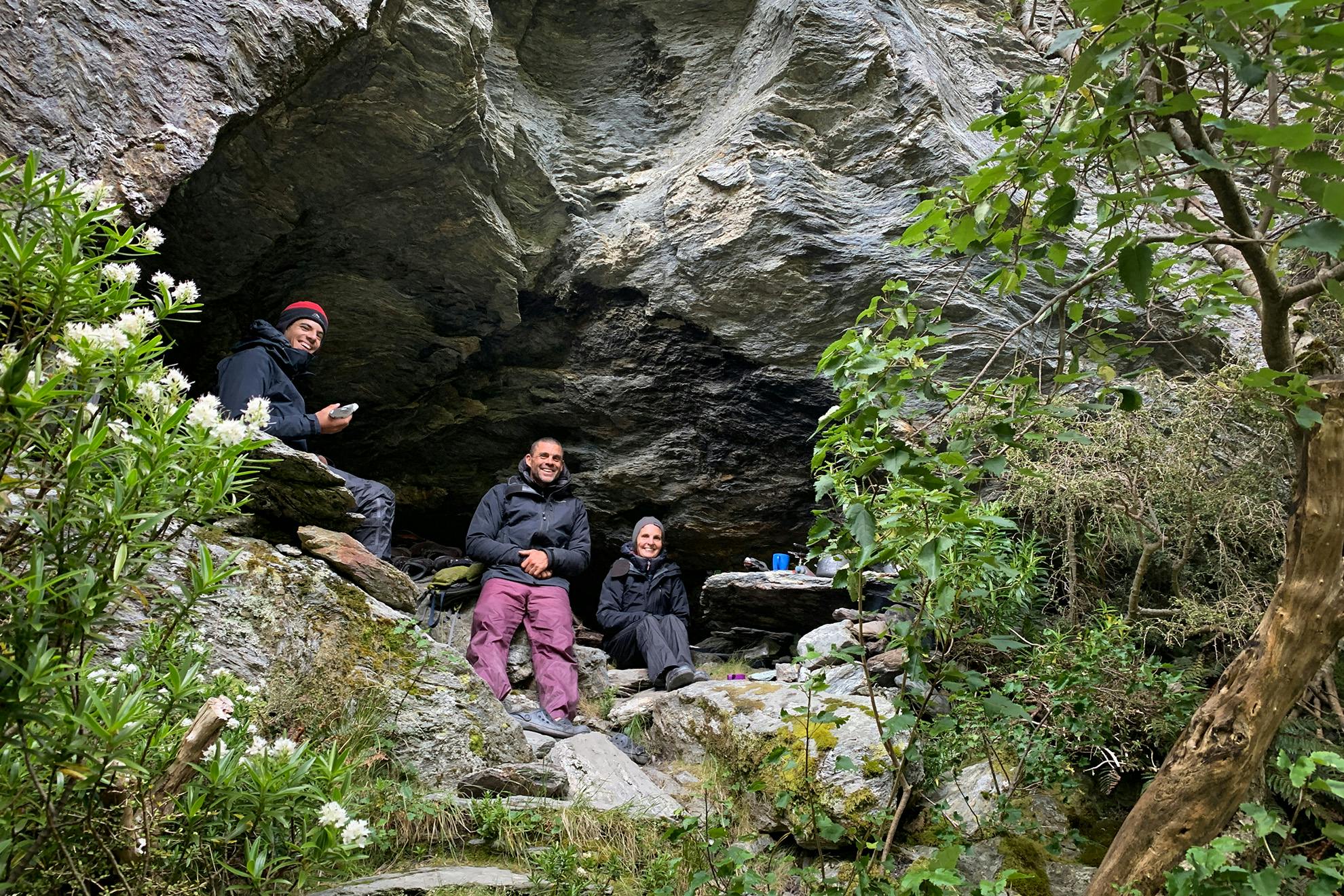
The Olivine Ledge is a wonderful tussock bench leading all the way from Fiery Creek to below Fohn Lakes. It’s fast and easy travel. We traversed the ledge until just past the outlet stream from the larger of the Fohn Lakes. The route then heads up, alongside the stream until the ridge is crested. Though Fohn Saddle is reached before Fohn Lakes, friends and family had advised us to make a side trip to the lakes, so we opted for this rather than going directly to the saddle.
It was only drizzling now and visibility was good. This was a fun section romping over the tussock lands and following the steep stream from the ledge to the outlet of the main Fohn Lake. The steely blue lakes, surrounded by severe steep-sided mountains and tawny tussocks, were spectacular. It was a worthy diversion.
We marched on towards Fohn Saddle in deteriorating weather. Over the saddle was Split Rock Biv, visible beside the Beans Burn 600m below; lunch and a snooze seemed not far away. But the descent proved tougher than we bargained for and we didn’t hit a ground trail or any cairns. Slithering through damp snow grass, prickly Spaniards and other assorted shrubbery took a long time. The highlight was coming across a lone mohua / yellowhead, perched on a flax flower. Mohua are endangered but predator trapping efforts in the Dart River seem to be helping the population.
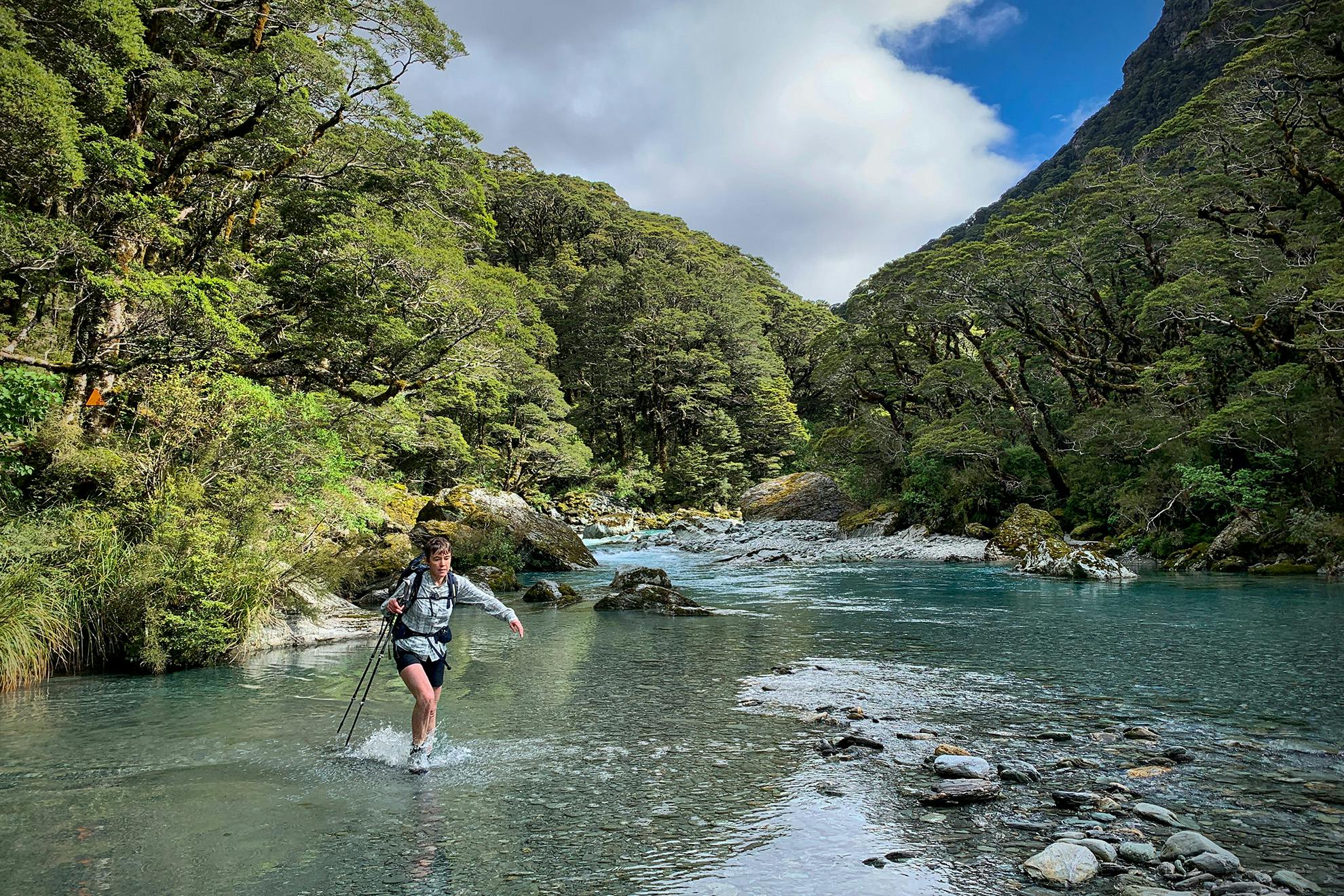
It was raining hard when we hit the Beans Burn at the cairn marking where those going in the opposite direction would start climbing. Subsequently, we learnt that we could have scooted down the upper Beans Burn on the true left, in an easy dry stream bed. We, however, scrabbled in and out of the river, sticking to the true right. Finally, we arrived at our much-anticipated accommodation and our night at Split Rock Biv was social and fun.
The final day was down the remainder of the Beans Burn. It was slow going to begin with, negotiating treefall and lots of clambering, but the route is mostly marked.
We met several parties travelling upstream. It was going to be another crowded night at Split Rock.
As we got further down, it became easier along a gentle gravel riverbed in the lower reaches of the burn and then the Dart River, which we joined opposite Chinamans Bluff.
The last section was the highway-like Lake Sylvan Track and we galloped along to complete the journey.
- Distance
- 60km (approx)
- Total Ascent
- 4200m (approx)
- Grade
- Moderate / Difficult
- Time
- 4-6 days in good weather
- Accom.
- Camping and rock bivouacs
- Access
- Routeburn Shelter or Sylvan Campsite
- Map
- CA09, CB09
GPX File
- Five passes (gpx, 39 KB)
GPX File
- Your device does not support GPX files. Please try a different device.





